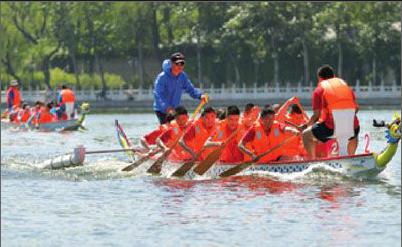Flowing Through Time
2014-09-23BydingYing
By+ding+Ying

Threading through Beijings famous and bustling Shichahai area and running hundreds of meters eastward by the lakeside, one can see ruins of the ancient Dongbuya Bridge. Though the bridge itself is long gone, and the water level much lower than before, the flourishing trees, quiet atmosphere and zigzagging alleys still make the area a favorite spot for local residents and tourists alike.
The Dongbuya Bridge, once an important feature along Chinas Grand Canal, is just one artifact that will benefit from the canals recent naming as a UNESCO World Heritage Site. At the 38th session of the UNESCO World Heritage Committee on June 22 in Doha, Qatar, the Grand Canal was officially added to the international organizations list, raising the number of Chinese sites on the roster to 47.
Ancient waterway
The World Heritage Committee cited the Grand Canal as the worlds longest and oldest artificial waterway as well as the largest and most widespread civil engineering project undertaken before the Industrial Revolution. It reflects Chinese peoples tremendous wisdom and resolution as well as Eastern civilizations early achievements in hydraulic engineering and project management. The canal has played a significant part in guaranteeing Chinas economic prosperity and social stability through the centuries.
In accordance with historical tradition, the Grand Canal is divided into 10 sections. The Beijing portion of the canal was first excavated during the Sui Dynasty (581-618) for grain transportation. What exists now of this section of the canal was largely excavated and drained during the Yuan (1206-1368), Ming (1368-1644) and Qing (1644-1911) dynasties. Until the year 1900, it had acted as an important grain transportation route for over 1,300 years. At the turn of the 20th century, the railway between Beijing and Tianjin came into operation and replaced the canal as the main mode of transportation. Today, the Beijing section includes 82 km of waterways and 24 sluices, and still runs through Beijings six districts from Changping in the northwest to Tongzhou in the east.
Sites in the capital city selected for inclusion in the UNESCO listing are two waterways and two relics: parts of the Tonghui River in downtown Beijing and Tongzhou, and ruins from the Wanning and Dongbuya bridges.
Shao Jun, an official with the Department of World Heritage, the State Administration of Cultural Heritage, explained that only the sections in better condition and with more relevance to the canal as a whole were selected for World Heritage Site status. “All World Heritage Sites share an ‘OUv principle: outstanding, universal and valuable,” Shao told Beijing Review.“The basic rule is that the original site must be of some worth, is authentic and also complete. It cannot be selected after modern reconstruction.” Like in other sections of the Grand Canal, only the best-preserved sites in the Beijing section were able to be included, Shao added.endprint
The Grand Canals success in being named a World Heritage Site has increased the variety of internationally recognized historical relics in Beijing, said Shu Xiaofeng, head of the Beijing Municipal Administration of Cultural Heritage. He added that it is significant in promoting the capital citys development as a cultural center. Beijing is now the Chinese city with the most World Heritage Sites.
Future protection plan
Even during the application period, maintenance was conducted to protect and preserve the waterways and historical sites along the Grand Canal, and achieved good results. Targets were set to sustain related work, explore further usage, and enhance protection efforts along the canal in the future.
“Being named a World Heritage Site is only the beginning. Future protection, preservation and management will be tougher challenges for listed sites,” Shao told Beijing Review. He warned that if a place fails to meet the standard requirements of UNESCO, it will be put on a list of endangered sites. In the future, if the condition of the place has not improved, it will likely have its title removed, which has happened before in other countries.
“World Heritage Sites are generally ‘living,which means that they are still in use,” said Shao. The Beijing section of the canal has been kept in use and in good condition, especially as a tourist attraction. Thus, future preservation and protection should not pose a tough challenge for the city, Shao added.
From 2000-07, the Beijing Municipal Government implemented measures to protect the citys historical sites, including the waterways and buildings along the canal, at a total cost of 330 million yuan ($53.7 million). The Dongbuya Bridge is one of the points of interest that was discovered and repaired during that period. The Beijing Municipal Administration of Cultural Heritage then conducted studies of the canal in 2007, completing the selection of heritage sites along the canal. In May 2009, the State Administration of Cultural Heritage confirmed the selection of 40 various heritage sites along the citys section of the Grand Canal, and in 2013, Beijing invested over 30 million yuan ($4.9 million) on renovations for the selected historical areas, greatly improving conditions there.
At a meeting on June 25 regarding the protection and management of the canals Beijing section, the Municipal Administration of Cultural Heritage outlined its plan to strengthen the preservation of the canal sites. These sites cover a total area of 7,781 hectares and fall into three categories: waterways and water sources, bridges and sluices, as well as ancient relics and architecture.endprint
According to the administration, the city has established management and monitoring systems for the canal sites. Wang Yuwei, an official with the administration, noted that the government will focus on improving the monitoring of the environment, water quality and river flow. This protection will cover all 40 heritage sites, including those that have not yet been selected for inclusion in the UNESCO listing. Wang said that many water bodies in the Beijing section perform landscape and drainage functions, with some lakes serving as reservoirs. Also, some bridges are still in use today.
According to Beijings protection plan, a water pollution prevention and control system is under construction through 2015. By then, industrial pollution sources inside the canal area will operate under national emission standards. The water ecosystem will be rehabilitated. Moreover, a cruise line along the Tonghui River will open in 2015 as well, allowing people to enjoy the river scenery by boat. The following year, archaeological projects in the ruins of the dynasties from 581-1234 will be completed, and by 2030, protective measures and usage of the canal section in Beijing will match the citys pace of modernization.
Wang said that canal sites vying for inclusion into the UNESCO listing are now undergoing renovations for further assessment. It is hoped that these sites will be added in the future, he said.endprint
